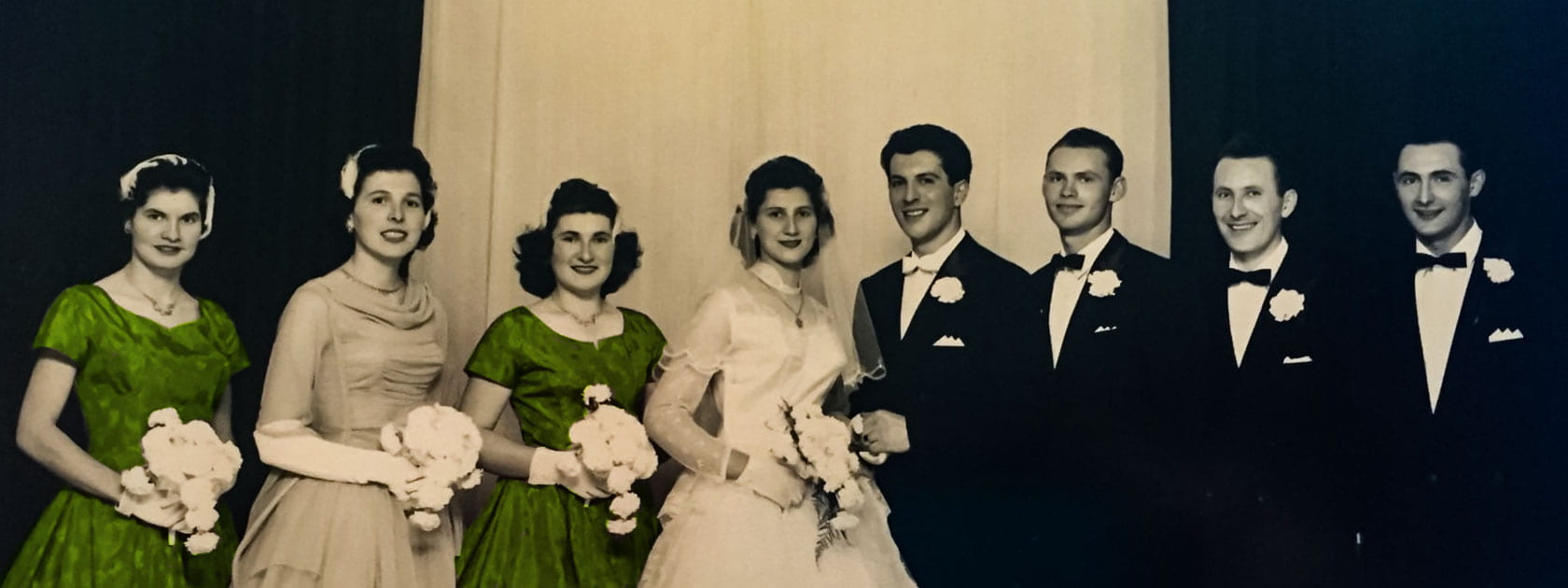
Written by: Grace Pellegrino
Written about: Rosa Bortolotto
Table of Contents
Introduction
On Monday, October 13th, 2025, I conducted an interview with my Nonna to capture the story of her immigration and life in Canada. Using a set of pre-determined questions and some follow up questions, this semi-structured interview caught a glimpse into the life of Rosa Bortolotto. With her permission, I recorded the video and audio of Rosa retelling her story at her home in Beamsville, Ontario. The purpose of this interview was to create an oral history and collect a personal archive. She happily retold her story, adding to the broader body of work dedicated to studying Italian Canadians. It documents her experiences, compares her life there to here, and encapsulates another unique and important story of an Italian Canadian Immigrant. This video is coupled with some pictures from her days as a young immigrants and newlywed, all coming together to form her special story. With some love, laughter, and a little wine, Rosa’s story adds to the legacy of the many vibrant Italian Canadian lives.
Interview Video
Summary of Interview
 Loading…
Loading…
Analysis
This interview about Rosa’s immigration story and life connects to, and differs from much of the course content in the HUMN 3800 course. Rosa recounts her experiences, thoughts, and feelings before, during, and after her immigration. Much of our discussion centered on topics related to work, family, culture, and identity, all recurring themes throughout the course. She connects to experiences including culture shock and gender differences but was luckier than most to land where she did in Canada.
Although Rosa was not subject to poverty or the same hardships that many other Italian immigrants faced, she did share some of the same experiences. Sidhwa (2019) explains the difficulty of moving between cultures and how taxing that can be on one’s individuality and identity. Rosa expressed notions of homesickness, writing letters to her family frequently at first, but slowly getting used to the way people lived in Canada. As well, when asked the question of where she considers home, her answer changed between both Italy and Canada. She ultimately decided that when she hears the word home, she still thinks of Italy, and it was the Italian aspects of Canada that made her feel more at home when she was here. This relates to many issues in the Engimatico (1995) documentary as well, including struggles with identity and self-esteem. Some individuals who immigrated to Canada expressed feeling more Italian than Canadian to some people, and the opposite to others, so they never felt fully accepted by either culture. This is similar to Rosa’s experiences of finding it difficult to determine if where she lived really felt like home. Additionally, Rosa saying her limited opportunity in Italy was what brought her to Canada relates to Harney (1988). She had less opportunity in Italy because of her inability to attend school or find work, making it impossible for her to stay there. There were schools and jobs in other towns and cities, but there was no transportation for her to get there. Just as Harney (1988) expressed, Rosa came to Canada for more opportunities and to build a better life than the one she had in Italy.
Rosa found what she was looking for when she came to Canada, being more opportunity and a better life. She was lucky enough to land in a home with wealthy family who took care of her, so she did not face much poverty or hardship. As discussed by Duliani (1994), many women in Canada faced extra trials because they were tasked with homemaking and working. While Rosa did have five children to take care of and made a wonderful home, she did not have to balance that with work life since my Nonno didn’t want her to work, as she said. Similarly, the documentary Barbed Wire and Mandolins (1994) talks about the ban of speaking the Italian language in public, churches, and workplaces. Rosa described the opposite experience, recounting that her days in Canada were filled with Italian Churches, friends, and gatherings at places like the Venetian Club in Hamilton. Here they celebrated their heritage through dance and socialization in their native language. Lastly, Rosa’s story differs from Harney’s (1988) account of “atimia”, which means ethnic self-disesteem. Rosa expressed a strong sense of ethnic pride, as shown when she highlighted the differences between Canadians and Italian immigrants. She pointed out that Italians always wanted the best – to dress, eat, look, and feel the best, while also working their hardest.
Citations
Duliani, M. (1994). The City Without Women: a chronicle of internment life in Canada during the second world war. In Canadian Cataloguing (pp. 9–24). essay, Mosaic Press.
Harney, Robert F. “Italian Immigration and the Frontier of Western Civilization.” The Italian Immigration Experience, 1988, pp. 1-24
Mortin, D., & Fogliato, P. (1995). Enigmatico. National Film Board of Canada. https://www.nfb.ca/film/enigmatico-en/
Sidhwa, B. (2019). Two Way Culture Shock. In Landscapes of Writings: Collected Essays by Bapsi Sidhwa (pp. 61–64). essay, Brock University.
Zavaglia, Nicola. (1994). Barbed Wire and the Mandolins. National Film Board of Canada.
Reflection
I learned a lot from this experience interviewing Rosa and taking on this new role. From personal things about her and my family, to academic insights about myself, this experience broadened my perspective. I was excited about the opportunity to learn more about my family history while gaining valuable practice of skills I could utilize in an academic or professional setting.
Rosa’s story, although unique in ways, connects to many of the immigration stories discussed in the academic discourse. One area of study that needs more investigation is that of Women’s unique experiences as discussed by Duliani (1994). Although asking follow-up questions helped clarify and deepen my understanding of her story, in the future I would like to dive deeper into the topic of her being a woman. This has enhanced my academic skills in investigating and determining how, when, and which questions to ask. As well, to continue to apply the same sense of excitement and interest I hope I portrayed to Rosa when listening to her story.
Going into the interview, I thought I’d already known all there was to know about Rosa and her life. I grew up living with her and never left her side, so she told me stories all the time, including ones from her time in Italy and her immigration. However, as she answered the questions, she revealed things I never knew she achieved or did. For example, I knew she could sew, but I wasn’t aware she worked making hats, shirts, doing alterations, and even making her own clothes. Additionally, I found it inspiring how grateful she was for her experience in comparison to her friends. Rosa acknowledged her privileged position landing in a house with rich people. She expressed that she tried to utilize this foothold to get even better at whatever it was she was doing at the time. She also revealed that although she loved her life in Canada, she wished she could have lived her life in Italy. This sign of sacrifice is also inspiring to me because she came here to get a better life not only for herself but also her future family. As a young woman, my Nonna’s story acts as motivation for me to continue working hard in school since she did not have that privilege. As well, to always carry myself with grace, kindness, and a lot of courage – just as she has for 97 years.
Photo Gallery








